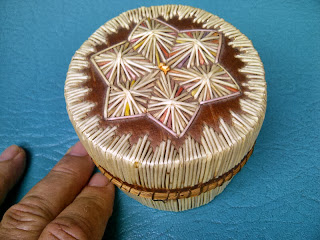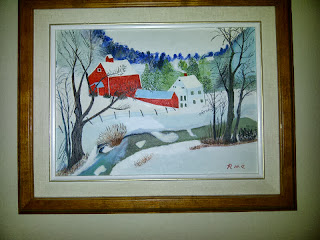My thinking around starting this blog was that it would be an effective means of promoting my upcoming book on the subject of folk art and my 30 year pursuit of antiques and folk art.
As I write this, my ninth post in the series, I thought it might be wise to step back and consider some of the basics about folk art at least as I understand them. Doing so might be helpful to individuals just discovering folk art for the first time. I'm sure that seasoned collectors of folk art won't mind this review.
 |
| Unknown Artist |
Ironically, it was folk art that led me to an appreciation and some understanding of formal art including the major art movements and significant developments in art in Europe and North America in the last century. A broader understanding, however superficial, has been helpful in my appreciation of all forms of art. I apologize in advance to any art history graduates who come across this blog post for the discrepancies herein.
What is Folk Art?
My definition of folk art is art that is created by individuals who are untrained in the formal or generally accepted rules of artistic creation. That's not to say that folk artists don't employ techniques found in the work of trained or academic painters because they often do. But at the same time folk artists don't feel bound by these rules and techniques because they simply, for the most part, are unaware of them. Folk Art is also a term that is used to capture a variety of other art forms such as primitive, native and outsider art although many people prefer to keep fairly sharp dividing lines between them. Some collectors like to focus on particular types of folk art, early native art, for example.
Traditional and Contemporary
A convenient way of approaching folk art is to divide it into two categories: traditional and contemporary. Like antiques, traditional folk art refers to work that was done some time ago. The turn of the century in 1900 is one dividing line to use. Work produced after 1900 can be thought of as contemporary. Work created before 1900 is traditional folk art.
Aesthetic and Utilitarian
Academic or trained artists create art for the sake of the art itself and do so in keeping with their artistic vision or intent whatever that might be...their aesthetic, if I understand that word correctly. But artistic creation can and does occur when the art is not the primary concern of the person who created it. Is an antique wall shelf with hearts and pinwheel decorations simply a utilitarian object or is it a piece of art that happens also to be a shelf? The point I am trying to make here is that art can be found anywhere on objects of all kinds.
 |
| Unknown Artist |
I should add that collectors, especially antique collectors, prize pieces where age, form and art combine. So, for example, a small, antique document box with untouched, painted decorations will be highly valued by collectors and, of course, the price will reflect that.
Some Characteristics
It's ironic that many folk artists don't describe themselves as such. In their minds there is no distinction. They are simply creating their art as they wish to do so. And each folk artist has their unique vision or interpretation of their surroundings. As a collector, it is fascinating to see these different interpretations. The subjects may be similar but the final products are uniquely different.
Some folk artists like Anna Robertson (Grandma Moses), Maud Lewis and Bill Traylor have become quite famous on a par with many well know academic painters. The prices for their paintings reflect that popularity. However, the potential for you or anyone to find an unknown, equally interesting and appealing folk art is very real. I would hazard to guess that in your immediate neighbourhood there could well be a brilliant folk artist working in obscurity. They are individuals who for whatever reason decided to pick up a brush, a pencil, a carving knife or a sewing needle and interpret the world around them in art. Their medium may be a painting, a carving, a textile, perhaps they've taken to painting on the surfaces of furniture.
Let me show you a couple of examples. These are paintings by artists that are relatively unknown. I say that because even though there paintings are signed, I do not know the artists. As you'll see though the artist in both cases was quite confident about what they were creating. It this "sureness" of mission, that is characteristic of very good folk art. There is nothing hesitant or faltering about this art.
 |
| Maria S. |
 |
| B. Green |
Again, consider this landscape painting of his. It is a common subject perhaps but Mr. McCart has interpreted the scene in his own manner and was completely successful in doing so. I imagine it may have been the farm where he was born. Isn't that blue line of trees in the distance interesting? Who would paint a line of trees blue? Didn't one of the French Impressionists paint strawberries blue?
 |
| Robert McCart |
 |
| Robert McCart |
Another point I would make here is that while often you will see similarities in different works, folk artists can and will surprise you with new and novel ways of artistic expression. With folk artists you must expect the unexpected.
So, is their an undiscovered folk artist in your community? I bet there is. You should make it your mission to find them. Best wishes in doing so.
This seems like a good point at which to stop. Thanks for reading.
Shaun
No comments:
Post a Comment